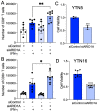ARID1A Deficiency Regulates Anti-Tumor Immune Response in Esophageal Adenocarcinoma
- PMID: 38001638
- PMCID: PMC10670331
- DOI: 10.3390/cancers15225377
ARID1A Deficiency Regulates Anti-Tumor Immune Response in Esophageal Adenocarcinoma
Abstract
ARID1A, a member of the chromatin remodeling SWI/SNF complex, is frequently lost in many cancer types, including esophageal adenocarcinoma (EAC). Here, we study the impact of ARID1A deficiency on the anti-tumor immune response in EAC. We find that EAC tumors with ARID1A mutations are associated with enhanced tumor-infiltrating CD8+ T cell levels. ARID1A-deficient EAC cells exhibit heightened IFN response signaling and promote CD8+ T cell recruitment and cytolytic activity. Moreover, we demonstrate that ARID1A regulates fatty acid metabolism genes in EAC, showing that fatty acid metabolism could also regulate CD8+ T cell recruitment and CD8+ T cell cytolytic activity in EAC cells. These results suggest that ARID1A deficiency shapes both tumor immunity and lipid metabolism in EAC, with significant implications for immune checkpoint blockade therapy in EAC.
Keywords: ARID1A; CD8+ T cells; IFN response; esophageal adenocarcinoma; lipid metabolism; tumor immunity.
Conflict of interest statement
The authors declare no conflict of interest. The funders had no role in the design of the study, sample collection, analyses, interpretation of the data, writing of the manuscript, or decision to publish the results.
Figures







Similar articles
-
Loss of the SWI/SNF-ATPase subunit members SMARCF1 (ARID1A), SMARCA2 (BRM), SMARCA4 (BRG1) and SMARCB1 (INI1) in oesophageal adenocarcinoma.BMC Cancer. 2020 Jan 6;20(1):12. doi: 10.1186/s12885-019-6425-3. BMC Cancer. 2020. PMID: 31906887 Free PMC article.
-
Next-generation sequencing of endoscopic biopsies identifies ARID1A as a tumor-suppressor gene in Barrett's esophagus.Oncogene. 2014 Jan 16;33(3):347-57. doi: 10.1038/onc.2012.586. Epub 2013 Jan 14. Oncogene. 2014. PMID: 23318448 Free PMC article.
-
Inhibition of the ATM/Chk2 axis promotes cGAS/STING signaling in ARID1A-deficient tumors.J Clin Invest. 2020 Nov 2;130(11):5951-5966. doi: 10.1172/JCI130445. J Clin Invest. 2020. PMID: 33016929 Free PMC article.
-
Treatment Strategies for ARID1A-Deficient Ovarian Clear Cell Carcinoma.Cancers (Basel). 2021 Apr 7;13(8):1769. doi: 10.3390/cancers13081769. Cancers (Basel). 2021. PMID: 33917230 Free PMC article. Review.
-
Targeting ARID1A mutations in cancer.Cancer Treat Rev. 2021 Nov;100:102287. doi: 10.1016/j.ctrv.2021.102287. Epub 2021 Sep 6. Cancer Treat Rev. 2021. PMID: 34619527 Review.
Cited by
-
CHK1 inhibition increases the therapeutic response to radiotherapy via antitumor immunity in ARID1A-deficient colorectal cancer.Cell Death Dis. 2025 Aug 1;16(1):584. doi: 10.1038/s41419-025-07912-6. Cell Death Dis. 2025. PMID: 40750787 Free PMC article.
References
-
- Morgan E., Soerjomataram I., Rumgay H., Coleman H.G., Thrift A.P., Vignat J., Laversanne M., Ferlay J., Arnold M. The Global Landscape of Esophageal Squamous Cell Carcinoma and Esophageal Adenocarcinoma Incidence and Mortality in 2020 and Projections to 2040: New Estimates from GLOBOCAN 2020. Gastroenterology. 2022;163:649–658.e2. doi: 10.1053/j.gastro.2022.05.054. - DOI - PubMed
Grants and funding
LinkOut - more resources
Full Text Sources
Research Materials

